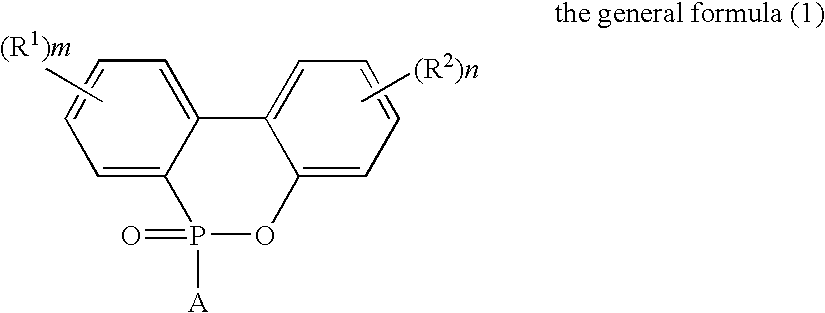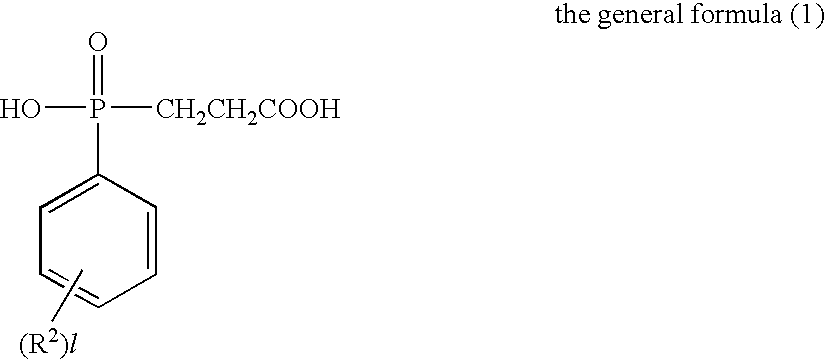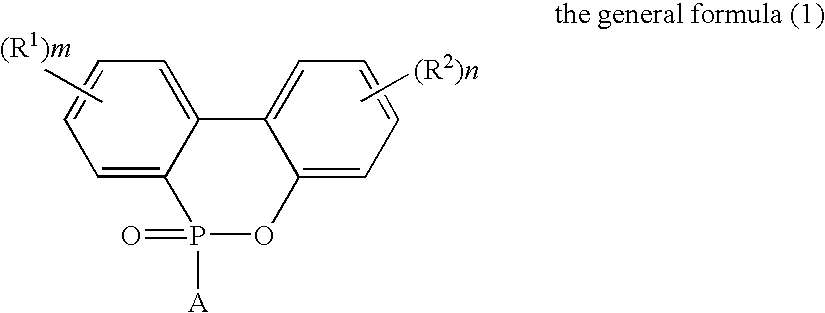Flame-Retardant Polyester and Process for Producing the Same
a flame-retardant polyester and flame-retardant technology, applied in the direction of organic chemistry, chemical apparatus and processes, group 5/15 element organic compounds, etc., can solve the problems of deterioration of function, inability to blend intended phosphorus amount, and bleedout of flame-retardant materials, so as to improve the production operability of polyester, improve the mechanical properties, and improve the effect of flame-retardant materials
- Summary
- Abstract
- Description
- Claims
- Application Information
AI Technical Summary
Benefits of technology
Problems solved by technology
Method used
Image
Examples
example 1
[0072]825 parts of terephthalic acid, 4 parts of trimellitic acid, 1006 parts of the phosphorus compound (i) (as 50%-ethylene glycol solution) and 297 parts of ethylene glycol were charged into a stainless-steel autoclave provided with a stirrer, a distillation column and a pressure regulator (this equipment was used for all of the following experiments) to further add 0.324 part of germanium dioxide and 2.1 parts of triethylamine thereto and perform esterification reaction at a temperature of 245° C. and a gage pressure of 2.5 kg / cm2 for 2 hours while sequentially removing water generated in the esterification. Subsequently, the temperature of the system was heated up to 280° C. in 1 hour to gradually reduce the pressure of the system to 0.1 mmHg in the meantime, and perform polycondensation reaction for 105 minutes under this condition. The phosphorus content of the obtained polymer was 30000 ppm such as to exhibit favorable flame retardancy. The intrinsic viscosity thereof was as...
example 2
[0073]825 parts of terephthalic acid, 4 parts of trimellitic acid, 1006 parts of the phosphorus compound (i) (as 50%-ethylene glycol solution) and 297 parts of ethylene glycol were charged into a stainless-steel autoclave provided with a stirrer, a distillation column and a pressure regulator (this equipment was used for all of the following experiments) to further add 0.324 part of germanium dioxide and 2.1 parts of triethylamine thereto and perform esterification reaction at a temperature of 245° C. and a gage pressure of 2.5 kg / cm2 for 2 hours while sequentially removing water generated in the esterification. Subsequently, the temperature of the system was heated up to 280° C. in 1 hour to gradually reduce the pressure of the system to 0.1 mmHg in the meantime, and perform polycondensation reaction for 105 minutes under this condition. The phosphorus content of the obtained polymer was 30000 ppm such as to exhibit favorable flame retardancy. The intrinsic viscosity thereof was as...
example 3
[0075]821 parts of terephthalic acid, 7 parts of trimellitic acid, 1005 parts of the phosphorus compound (i) (as 50%-ethylene glycol solution) and 296 parts of ethylene glycol were charged into a stainless-steel autoclave to further add 0.324 part of germanium dioxide and 2.1 parts of triethylamine thereto and perform esterification reaction at a temperature of 245° C. and a gage pressure of 2.5 kg / cm2 for 2 hours while sequentially removing water generated in the esterification. Subsequently, the temperature of the system was heated up to 280° C. in 1 hour to gradually reduce the pressure of the system to 0.1 mmHg in the meantime, and perform polycondensation reaction for 105 minutes under this condition. The phosphorus content of the obtained polymer was 30000 ppm such as to exhibit favorable flame retardancy. The intrinsic viscosity thereof was as high as 0.89 dl / g though phosphorus was contained at high concentration. That is, it was signified that polymerization velocity was hi...
PUM
| Property | Measurement | Unit |
|---|---|---|
| melt viscosity | aaaaa | aaaaa |
| mol % | aaaaa | aaaaa |
| melt viscosity | aaaaa | aaaaa |
Abstract
Description
Claims
Application Information
 Login to View More
Login to View More - R&D
- Intellectual Property
- Life Sciences
- Materials
- Tech Scout
- Unparalleled Data Quality
- Higher Quality Content
- 60% Fewer Hallucinations
Browse by: Latest US Patents, China's latest patents, Technical Efficacy Thesaurus, Application Domain, Technology Topic, Popular Technical Reports.
© 2025 PatSnap. All rights reserved.Legal|Privacy policy|Modern Slavery Act Transparency Statement|Sitemap|About US| Contact US: help@patsnap.com



